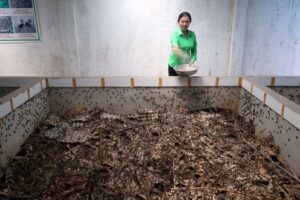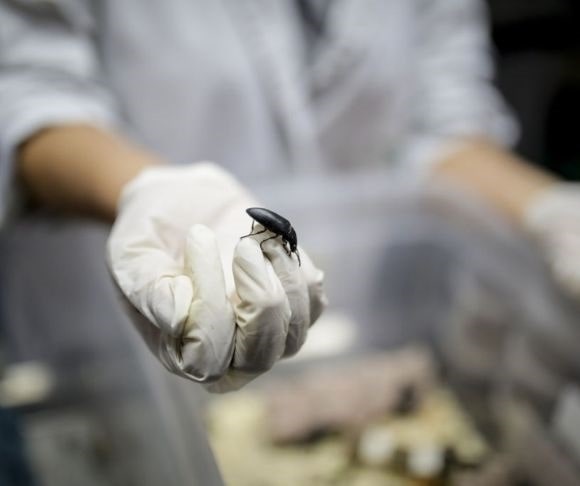The good people residing in and about the European Union are enjoying an extra crunch in their breakfast cereals and pizza as such foods are featuring a crushed cricket additive. Of course, there is a process of defatting said insect and ensuring its bowels are emptied before freezing. That makes us all feel better. But Disney’s Jiminy is now in the witness protection program and wishing on a star for salvation in case the United States follows suit.
 The European Commission recently approved the sale of lesser-mealworm larvae in powder, frozen, paste, and spice-consistent dried forms. The cricket comes in a partially defatted powder. It’s not uncommon for people to indulge in a chocolate-covered ant or scorpion; it’s a novel approach to being cool. But what if no one told the consumer you are, in fact, eating bugs? Would you still buy that candy, cookie, or granola bar if food producers came clean?
The European Commission recently approved the sale of lesser-mealworm larvae in powder, frozen, paste, and spice-consistent dried forms. The cricket comes in a partially defatted powder. It’s not uncommon for people to indulge in a chocolate-covered ant or scorpion; it’s a novel approach to being cool. But what if no one told the consumer you are, in fact, eating bugs? Would you still buy that candy, cookie, or granola bar if food producers came clean?
But You’ve Been Munching on a Cricket for Years
Americans have consumed insects unknowingly for years. Did you not notice the secretions from lac bugs after that last hankering for Junior Mints, Tootsie Roll, Red Hots, or Boston Baked Beans was resolved? And those little critters are relatively good for folks if they can get past the gag reflex: Insect protein is a potent source of amino acids, rich in vitamins, minerals, and polyunsaturated fatty acids. And low in fat — less than 5 grams per serving.
EU news aggregate Deutsche Welle reported:
“Between 35% and 60% of the dry weight of insects is made up of protein. The lower end of the range is greater than most plant protein sources, and the upper end is higher than meat and eggs. Insects are better than livestock at turning calories in their feed into calories in their body. They also breed fast and gain weight quickly.”
Okay, maybe this isn’t such a horrible idea. Or is it? People for the Ethical Treatment of Animals (PETA) have been sounding the alarm for years and campaigning to have misguided corporations change their bug additive menus. On a webpage call for intervention, their angst is palpable:
“Nearly 100,000 bugs die to produce about 1 pound of shellac flakes, which are combined with alcohol to make a confectioner’s glaze. By glazing candy with these secretions, companies such as Tootsie Roll Industries and Ferrara are killing insects — and customers’ appetite.”
And the PETA folks have been successful. In 2012, they browbeat Starbucks into removing a red coloring additive, cochineal extract, from their Strawberry Frappuccino. The red dye is mined by crushing female Dactylopius coccus, a tiny beetle bug that lives on several species of cacti in Central and South America. But consumers hungry for that red accompaniment can find it in strawberry yogurt.
Yet PETA is not on the same page as climate-change alarmists: It’s a battle no one saw coming.
Bug Farms

(Photo by: Godong/Universal Images Group via Getty Images)
A virtuous eco-society. That phrase is used as a mantra by the World Economic Forum (WEF) in its quest to save the planet from an apocalyptic climate catastrophe. It imagines a world where insects feast on other waste from processes like “spent grains from brewery operations.” As a result, the bugs get good food, the hypothetical brewery has less waste, and landfills aren’t overwhelmed. And we all know that garbage dumps scattered around large cities “cause 20% of global anthropogenic methane emissions and [are] second highest producers of greenhouse gas.”
Sounds plausible. But the WEF does not disclose the penchant for parasitic infections from using farmed insects. The National Library of Medicine published a study that might be good for EU folks to review. It found that “parasitic developmental forms were detected in 244 (81.33%) out of 300 (100%) examined insect farms.” So to save the climate, eat a cockroach and get a parasite for free.
Don’t Bug Out Yet
Americans have been ingesting variants of insect excretions and indulging in candied ants and cockroaches for years. The trend to farm insects and use them in foods to protect the climate may render consumers in the United States somewhat speechless. But any day now, the practice may be drifting across the pond. Anything is possible. On the bright side, everyday people can start a house cricket, mealworm, or cockroach farm in their spare room or basement and sell the tiny livestock replacements to fancy restaurants. In this economy, a bug-in might just be the way to go.




